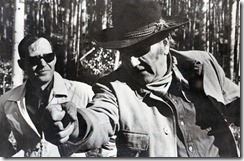The Bodies and Soul of a Book
January 21, 2011 Leave a comment
 Earlier this week Joseph Esposito whipped up an interesting blog post over in the Scholarly Kitchen. He really ladled it on thick. He argued that the current way of thinking about books as some spirit or essence that can be plopped into any of a growing number of bowls (printed, PDF, ePub, Rocket, Pocket, Kindle, Spindle, etc.) is mistaken, misguided, and unpalatable. He suggested that most authors write for a certain type of vessel. Evidently the author, while writing, imagines not only an ideal reader, but also the ideal finished product, the spirit of the text instantiated in a very specific dish. We must recognize and respect, Esposito cautions, the authority of the author to select the best vessel for the spirit of his or her utterance.
Earlier this week Joseph Esposito whipped up an interesting blog post over in the Scholarly Kitchen. He really ladled it on thick. He argued that the current way of thinking about books as some spirit or essence that can be plopped into any of a growing number of bowls (printed, PDF, ePub, Rocket, Pocket, Kindle, Spindle, etc.) is mistaken, misguided, and unpalatable. He suggested that most authors write for a certain type of vessel. Evidently the author, while writing, imagines not only an ideal reader, but also the ideal finished product, the spirit of the text instantiated in a very specific dish. We must recognize and respect, Esposito cautions, the authority of the author to select the best vessel for the spirit of his or her utterance.
Esposito argues that it is erroneous to distinguish the text from the text-bearing device. “Text” and “text-bearing device” are my terms, not his. I’ve been using them for years to differentiate the aspect of a book that is the text – the ideas, arguments, narrative, sentiments, style, etc. — from the book as a physical object – so much paper, glue, and ink, or, now, plastic, glass, and gossamer digits.
 Esposito asserts that such dualism is false and misleading thinking. The text is not the spirit, nor the text-bearing device the body, the “mere mortal coil.” What medieval rubbish. For Esposito, the text-bearing device informs the text, rather than the other way around. “…the creation of a text is a dialogue between the ideas and words of the author and the limitations imposed by its container.” Writers are like tennis players, ever mindful of the net and the boundary lines. The reader, evidently, is Bobby Riggs, pandering to the crowd and belittling the game. Esposito asserts that changing the container of the text changes the text. “The problem with getting books out of their containers is that books are their containers.”
Esposito asserts that such dualism is false and misleading thinking. The text is not the spirit, nor the text-bearing device the body, the “mere mortal coil.” What medieval rubbish. For Esposito, the text-bearing device informs the text, rather than the other way around. “…the creation of a text is a dialogue between the ideas and words of the author and the limitations imposed by its container.” Writers are like tennis players, ever mindful of the net and the boundary lines. The reader, evidently, is Bobby Riggs, pandering to the crowd and belittling the game. Esposito asserts that changing the container of the text changes the text. “The problem with getting books out of their containers is that books are their containers.”
I don’t buy his argument. Reality intrudes. Think of all the texts that appear in multiple containers, perhaps first as a series of chapters in some periodical, then as a published thingy, then, perchance, anthologized, which must be either the Elysian Fields or the Tartarus for any self-respecting text. Dickens wrote most of his “novels” as monthly serial installments of usually three chapters each, with a big dessert of six chapters as the final course. All these years we’ve been thinking we were reading his novels, when really we were reading his serials. Which container shall rule?
 By the bye, I once read Bleak House with a friend via the installment plan. It took two years, as I recall. We read an installment, then chatted about it, then waited a month before reading the next installment. It was a completely different experience than reading a Dickens thingy more-or-less straight through. And, of course, Eric and I reading the installments still did not experience Dickens’ text the way he probably envisioned, because we had the whole thing in our hands all the time, not some slim thing on cheap paper, and the society in which we lived while we read was not all abuzz about that unfolding text. No one at the club (to which I’d belong, if I weren’t unclubbable) ever sauntered over to me with a glass of sherry in hand and inquired, “I say, old chap, what do you make of the most recent number of that thingy Chuck Dickens is writing?”
By the bye, I once read Bleak House with a friend via the installment plan. It took two years, as I recall. We read an installment, then chatted about it, then waited a month before reading the next installment. It was a completely different experience than reading a Dickens thingy more-or-less straight through. And, of course, Eric and I reading the installments still did not experience Dickens’ text the way he probably envisioned, because we had the whole thing in our hands all the time, not some slim thing on cheap paper, and the society in which we lived while we read was not all abuzz about that unfolding text. No one at the club (to which I’d belong, if I weren’t unclubbable) ever sauntered over to me with a glass of sherry in hand and inquired, “I say, old chap, what do you make of the most recent number of that thingy Chuck Dickens is writing?”
Alas, the author can imagine any container he or she wishes, but, once the text has been released into the wild, we readers, publishers, aggregators, anthologizers, hackers, movie producers, made-for-cable movie producers, and librarians will knead, pound, and extrude that text into whatever darn dish we jolly well please.
 As a reader, I chafe at Esposito’s characterization of the relationship between the text and the text-bearing device, between the soul of the book and its bodies. One of my favorite books is Norwood by Charles Portis. I’ve read it auditorily as a narrated audio book, as well as visually as a printed paperback. (I steer clear of the 1970 movie version starring Glen Campbell, because evidently it’s tasteless.) While these were two different, distinct reading experiences, at some level I still felt that I was experiencing the same text. The soul shown forth. I laughed at the same parts, Joe. Re-reading digitally the picaresque adventures of Norwood Pratt probably is in my future, and it will be a good experience, and I’ll recognize the text as an old spiritual friend.
As a reader, I chafe at Esposito’s characterization of the relationship between the text and the text-bearing device, between the soul of the book and its bodies. One of my favorite books is Norwood by Charles Portis. I’ve read it auditorily as a narrated audio book, as well as visually as a printed paperback. (I steer clear of the 1970 movie version starring Glen Campbell, because evidently it’s tasteless.) While these were two different, distinct reading experiences, at some level I still felt that I was experiencing the same text. The soul shown forth. I laughed at the same parts, Joe. Re-reading digitally the picaresque adventures of Norwood Pratt probably is in my future, and it will be a good experience, and I’ll recognize the text as an old spiritual friend.
I agree with Esposito that over time the technologies of the containers for books affect the types of books we write. This is a form of technological determinism against which I want to rebel, but must acknowledge and cannot argue away. The economics and legal structures underpinning disseminated writing affects how we write and read, too. Esposito’s argument hasn’t motivated me to rethink the way I understand the fundamental relationship between texts and text-bearing devices, but it has reinforced my growing appreciation for the nuances and varieties of text-bearing devices – of the body types these wonderful souls can inhabit and inspire.
 Esposito stirs Frost several times into his post, so I’ll spread a little Twain as some frosting for this muffin. During the print era, when the printed goblet ruled supreme in our minds and in our hands, we erroneously imagined that all writers were writing in the same dialect and not really succeeding. In the digital era, a veritable smorgasbord of tasty text-bearing dishes will emerge. I’m with Huck. “In a barrel of odds and ends it is different; things get mixed up, and the juice kind of swaps around, and the things go better.”
Esposito stirs Frost several times into his post, so I’ll spread a little Twain as some frosting for this muffin. During the print era, when the printed goblet ruled supreme in our minds and in our hands, we erroneously imagined that all writers were writing in the same dialect and not really succeeding. In the digital era, a veritable smorgasbord of tasty text-bearing dishes will emerge. I’m with Huck. “In a barrel of odds and ends it is different; things get mixed up, and the juice kind of swaps around, and the things go better.”
While Esposito’s basic thesis causes me concern, I relish some of his details. For instance, he offers a good tentative classification of six types of ebooks that the new ereading technologies seem to afford.
- “The Institutional Book is a record of a text; the aim is to maintain in digital form all that we have come to expect from print.” In other words, an institutional book is just a printed book digitized, with as little alteration in conception and execution as possible. Reading an institutional book on a PP ICE (personal, portable information, communication, and entertainment appliance) is familiar and comforting, but an institutional book does not really capitalize or realize the affordances inherent in ereading on a PP ICE.
- The second type of digital book Esposito enumerates is what he calls the Classic e-book. “An e-book is a Classic when it embodies the primary virtue of a printed book — namely, it mostly disappears from our awareness as we become immersed in the text. This was one of the declared goals of the Kindle, and in my view, Amazon has been very successful at this. A Classic E-book provides a reading experience that is just a tad different from a familiar printed book.” So, when the reader becomes immersed in a good ebook, it flies free of its institutional, pulpy status and becomes a classic.
- An Enhanced e-book introduces other elements, such as audio, video, and computer simulations, into the text. As Esposito sees it, with the emergence of the enhanced e-book, “…all the affordances of computers are now at the disposal of the creator.”
- The fourth type of ebook that Esposito outlines he calls a Muscular e-book, a phrase used “…to describe books that invite an almost aggressive reading style” He seems to have textbooks, technical manuals, and such truck in mind, although I can imagine many possible muscular reading experiences of philosophical and religious texts. I’ve been challenging Plato to a best two falls out of three match for decades.
- The Social book will be communal in some ways, from a simple wrapping of comments and commentary from various individuals around the primary text to a truly communal text, such as a wiki. Gentle reader, please don’t run for the hills at the mere mention of a wiki. Some people see this type of ebook as the future for ereading. The old-fashioned way of reading silently alone will die off with the current generations as the new age of a reader’s paradise of communal reading dawns.
- The sixth and final type of book Esposito envisions is the Staccato Book. The cell phone novel – short and pithy like a string of text messages that would make Hemingway suicidal – is a good example of the Staccato Book as a type.
 Esposito seems to suggest that the better writers of the ereading era with think long, hard, and creatively about how these new containers and affordances will shape and sway what they utter and how they utter it. “…understanding the nature and affordances of the container are very much a part of the creative act of writing a book in the first place.” Rightly so, but the author doesn’t always get what he or she imagined. I’ve heard tell that Faulkner wanted to have the text of The Sound and the Fury presented in different colors, but his publisher (Grady Fring, no doubt), ever mindful of costs, nixed the idea. Evidently Willa Cather was very attentive to fonts and page layouts, but I imagine subsequent printings of her works have drifted away from her original intentions.
Esposito seems to suggest that the better writers of the ereading era with think long, hard, and creatively about how these new containers and affordances will shape and sway what they utter and how they utter it. “…understanding the nature and affordances of the container are very much a part of the creative act of writing a book in the first place.” Rightly so, but the author doesn’t always get what he or she imagined. I’ve heard tell that Faulkner wanted to have the text of The Sound and the Fury presented in different colors, but his publisher (Grady Fring, no doubt), ever mindful of costs, nixed the idea. Evidently Willa Cather was very attentive to fonts and page layouts, but I imagine subsequent printings of her works have drifted away from her original intentions.
Maybe we should embrace the idea of authors’ cuts of their works. Perhaps a few years hence, as we flip digitally to the verso of the title page on our ultra slim and sleek portable devices, a hologram of the author will rez and announce with august authority, “I’m the author, and I approve this institutional, classical, muscle-bound body for the soul of my book. If you mess with it, you mess with me.”